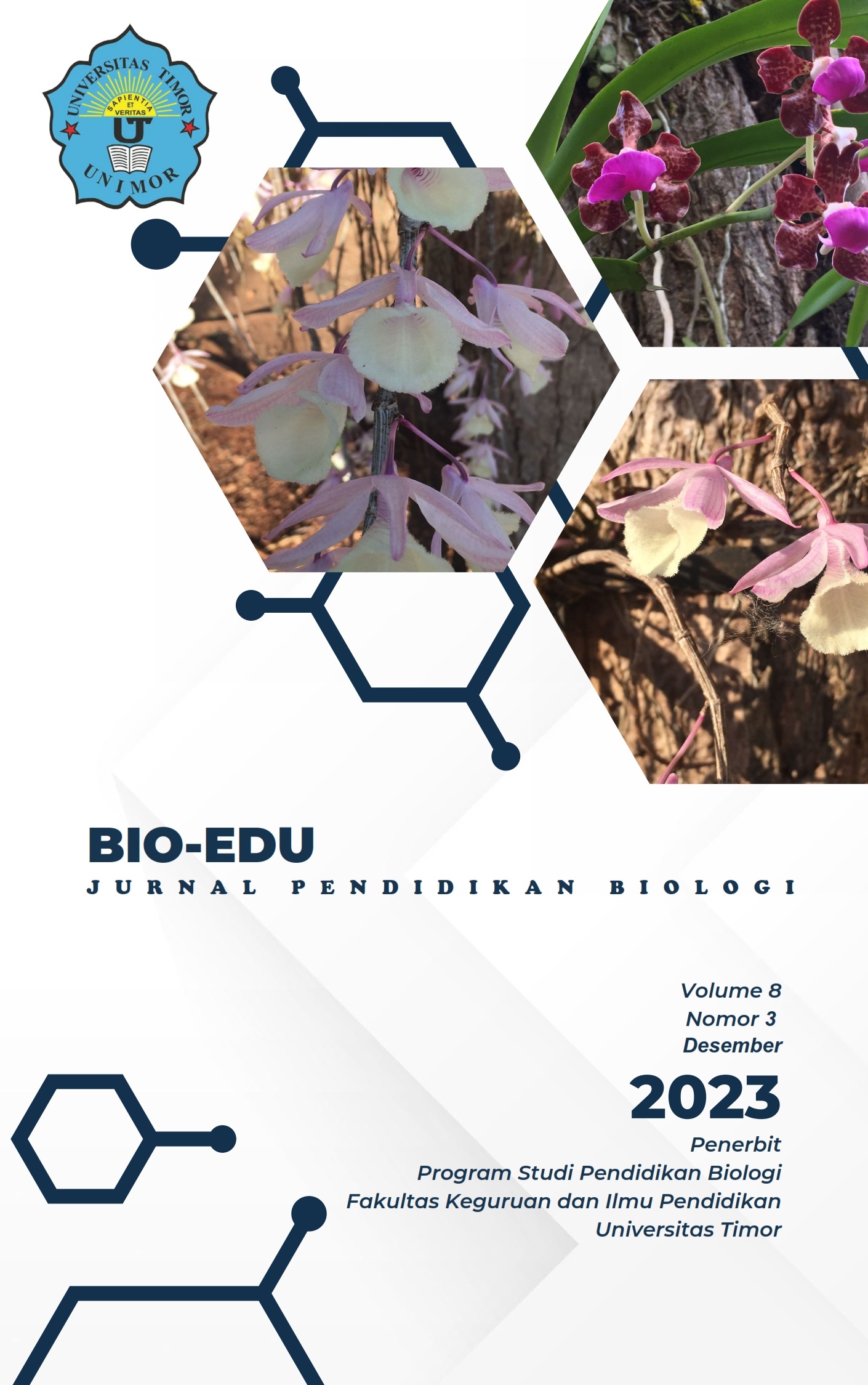COMMUNITY STRUCTURE AND DIVERSITY OF BENTHIC MACROINVERTEBRATES IN ALAM KANDUNG WATERFALL TULUNGAGUNG REGENCY
Main Article Content
Abstract
This research aims to determine the profile of the community structure and diversity of benthic macroinvertebrates in Alam Kandung Waterfall. Sampling was carried out at six stations of ± 100 individuals or stations that use surber net and hand net. Data collection for each station includes the composition and density of each species which is used to calculate taxa richness, abundance, IVI (Important Value Index), and diversity index (H'). The results showed that 37 taxa from 11 classes were found and varied at each station. At the first station, the highest taxa were found with a total of 19 taxa, and the lowest taxa at the second station with 7 taxa. The highest abundance is known at the first station and the lowest at the sixth station. The IVI results show that the first and second stations are dominated by the type of Sulcospira testudinaria which is sensitive to pollutants, and the third station and fourth are dominated by Tarebia granifera and Vellidae. The fifth station was dominated by Corixidae, while Thiara scraba and Atyidae were found in all stations. The results of the diversity index show that the first and fourth are lightly polluted, the second station is moderately polluted and the rest are not polluted. It can be concluded that the quality of waterfalls in Alam Kandung is still in a good category, reflected by the diversity of taxa and the presence of riparian vegetation.
Article Details
The Authors submitting a manuscript do so on the understanding that if accepted for publication, the copyright of the article shall be assigned to BIO-EDU: Jurnal Pendidikan Biologi and Departement of Biology Education, Universitas Timor as the publisher of the journal. Copyright encompasses rights to reproduce and deliver the article in all form and media, including reprints, photographs, microfilms, and any other similar reproductions, as well as translations.
BIO-EDU journal and Departement Biology Education, Universitas Timor, and the Editors make every effort to ensure that no wrong or misleading data, opinions, or statements be published in the journal. In any way, the contents of the articles and advertisements published in BIO-EDU are the sole and responsibility of their respective authors and advertisers.
Users of this website will be licensed to use materials from this website following the Creative Commons Attribution-ShareAlike 4.0 International License.
References
Arimoro, F.O & Ikomi, R.B. (2008). Ecological integrity of upper warri river, niger delta using aquatic insects as bioindicators. Ecological Indicators, 9(3), 455-461.doi: 10.1016/j.ecolind.2008.06.006
Djajasasmita, M. (1999). Conch and rice field mussels. Bogor: LIPI Biology Research and Development Center. 57.
Edmondson W.T. (1959). Freshwater biology (second ed). New York, USA : John Wiley and Sons Inc.
Istianingsih, N. R., & Listiawan, D. A. (2010). Conch and mussels from rivers in the karst area of Gunung Kidul. Journal of Tropical Fauna, 20(1), 1-10.doi: 10.52508/zi.v20i1.2342
Jutting W.S.S. (1956). Critical revision of the javanese freshwater gastropods. Bogor : Zoologicum Borgoriense Museum.
Kartikasari, D., Retnaningdyah, C., & Arisoesilaningsih. E., (2013). Application of water quality and ecology indices of benthic macroinvertebrate to evaluate water quality of tertiary irigation in malang district. The Journal of Tropical Life Science, 3(3), 193-201.
Kaller, M.D & Hartman, K.J. (2004). Evidence of a threshold level of find sediment accumulation for altering benthic macroinvertebrate communities. Hydrobiology, 518, 95-104. doi: 10.1023/B:HDYR.0000025059.82197.35
Kelly, C., Mitrasetia, T., and Sugardjito, J. (2017). An Assessment of a tropical urban stream using benthic macroinvertebrates as a bio-indicator in muara angke, jakarta, indonesia. International Journal of Bonorowo Wetlands, 7(2), 65-73. doi: 10.13057/bonorowo/w070202
Kratzer, E. B., et. al. (2006). Macroinvertebrate distribution in relation to land use and water chemistry in new york city drinking-water-supply watersheds. Journal of the North American Benthological Society, 25(4), 954–976. doi: 10.1899/0887 3593(2006)025[0954: MDIRTL]2.0.CO;2
Mandaville, S.M. (2002). Benthic macroinvertebrates in freshwaters taxa tolerance values, metrics, and protocols. English: Soil & Water Conservation Society of Metro Halifax.
Quigley, M. (1977). Invertebrates of streams and rivers. a key to identification. London : Hooder & Stoughton Educational Division.
Richardson, D. M. (2007). Riparian vegetation: degradation, alien plant invasions, and restoration prospects. Diversity and Ditributions, 13(1), 126-139. doi: 10.1111/j.1366-9516.2006.00314.x
Ristiyanti, M., Marwoto, et. al. (2011). Java island freshwater snails (mollusks, gathropods). Bogor: Center for Biological Research-LIPI.
Setiawan, D. (2008). Study of macrozoobenthos communities in the waters downstream of the lematang river around the lower market area of Lahat Regency. Journal of Science Research, 9, 12-14.
Suwignyo, S., Widigdo, B., Wardiatno, Y., & Krisanti, M. (2005). Water avertebrates vol. 1. Jakarta: Swadaya.
Tarwotjo, U., Rahadian, R., and Hadi, M. (2018). Community structure of macrozoobenthos as bioindicator of pepe river quality, mojosongo boyolali. Journal of Physic: Conference Series, 1025(1), 1-7. doi: 10.1088/1742-6596/1025/1/012039
Wahyudi, A. (2020). The development of natural tourism into an environmentally friendly tourist area. Journal of Social and Political Sciences, 13(2), 106-116.

